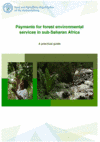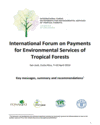Mainstreaming ecosystem services and biodiversity into agricultural production and management in East Africa
Biodiversity and ecosystem services are at the heart of many solutions for sustainable increased in agricultural productivity. These not only deliver better outcomes for food and nutrition security but also reduce externalities of production.
This document provides technical guidance for consideration in National Biodiversity Strategies and Action Plans (NBSAPs) to minimize the use of agro-chemicals.
Payments for forest environmental services in sub-Saharan Africa: A practical guide
Regional and global forestry forums have called to strengthen capacity for effectively developing and implementing payment schemes for environmental services in sub-Saharan Africa. In particular, the 18th session of the African Forestry and Wildlife Commission called for the enhancement of the institutional capacities of member countries and the sharing of knowledge on payment schemes for forest environmental services at national and sub-regional levels.
This document focuses on forest-based environmental services and compiles lessons applicable in sub-Saharan Africa generated by initiatives in the sub-region and other relevant regions.
Sustainable financing for forest and landscape restoration
FAO and the Global Mechanism of the UNCCD have joined efforts to prepare this discussion paper on sustainable financing for FLR. It provides an overview of existing funding sources and financial instruments that could be used and adapted specifically for the implementation of FLR efforts at the national, regional and global levels.
It identifies innovative financing mechanisms to support the achievement of these global targets and discusses the main challenges for enhanced FLR financing. Based on lessons learned through many related initiatives, it also proposes solutions to support the enabling conditions needed for sound FLR investments. This discussion paper will help FLR stakeholders better understand the financial architecture related to FLR and identify areas that need further action to unlock the potential of sustainable financing mechanisms for FLR.
International forum on Payments for Environmental Services of tropical forests
Policy brief 8: Payment for Environmental Services
Two institutional mechanisms for managing watersheds have been increasingly adopted worldwide: Payments for Environmental Services (PES) and Compensation for Environmental Services (CES). Their adoption is based on the increasing awareness that upstream activities determine the quality and quantity of the environment downstream. Their rationale is the need to provide incentives to help guarantee hte provision of these services.
The creation of such incentives needs, however, to avoid the risk of transforming them, and water in particular, into a commodity, to the point where emerging private rights may be detrimental to the basic rights and livelihood opportunties of the rural populations. The creation of these financial schemes could play a leading role in the improvement of livelihoods of upstream smallholders.
Greening the Economy with Agriculture (GEA)
Greening the Economy with Agriculture (GEA) seeks to contribute to the definition and implementation of the green economy in the context of sustainable development, food security and poverty alleviation through the mobilization of the food and agriculture sector.
As part of the GEA initiative, a joint FAO/ OECD Expert Meeting on Greening the Economy with Agriculture was held in Paris, France from 5-7 September 2011.
Payments for Environmental Services: What role in sustainable agricultural development?
PES is but one of many different instruments that can complement and stimulate an enabling policy environment for sustainable agricultural development. Currently the role of PES programmes in supporting sustainable agricultural development is quite limited. Recent surveys of the literature documenting PES experiences highlight three main features of such programmes as they are currently being implemented:
- Most do not demonstrate additionality and suffer from a lack of appropriate targeting;
- Most are designed with multiple objectives; and,
- Most remain primarily or entirely funded by the public sector.
In this paper, we argue that a public-sector-driven process of building PES programme readiness, which includes building partnerships with the private sector, is key to realizing the potential of this policy instrument to support sustainable agricultural development.
Payments for Ecosystem Services and food security
The concept of Payment for Ecosystem Services (PES) has emerged as a challenge to the all-too-prevalent tradition of taking the Earth’s natural resources for granted. PES highlights a global continuum, illustrating the relationship between our lifestyles, the demands associated with our production and consumption patterns, and the effects those demands have on close or distant ecosystems.
This book is meant to take those with background knowledge into new realms of technical understanding, but also to take newcomers to the PES mandate on a thoughtful journey, raising awareness in their consciousness as to what is needed and what can be accomplished by individuals with a strong sense of commitment. A functioning PES system has the potential to renew individuals’ shared sense of responsibility and involve them in supporting initiatives that can contribute to the collective preservation of our planet










